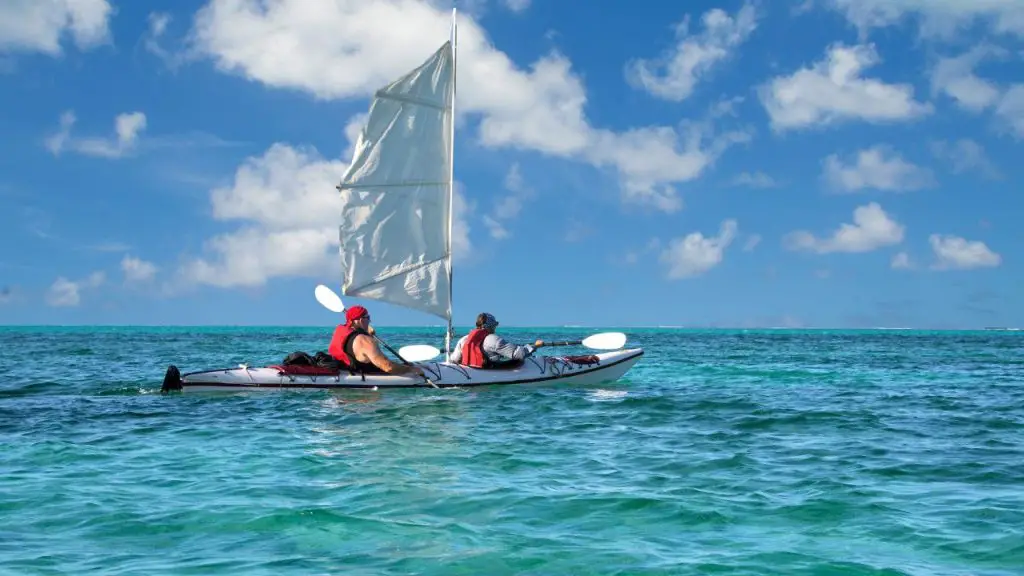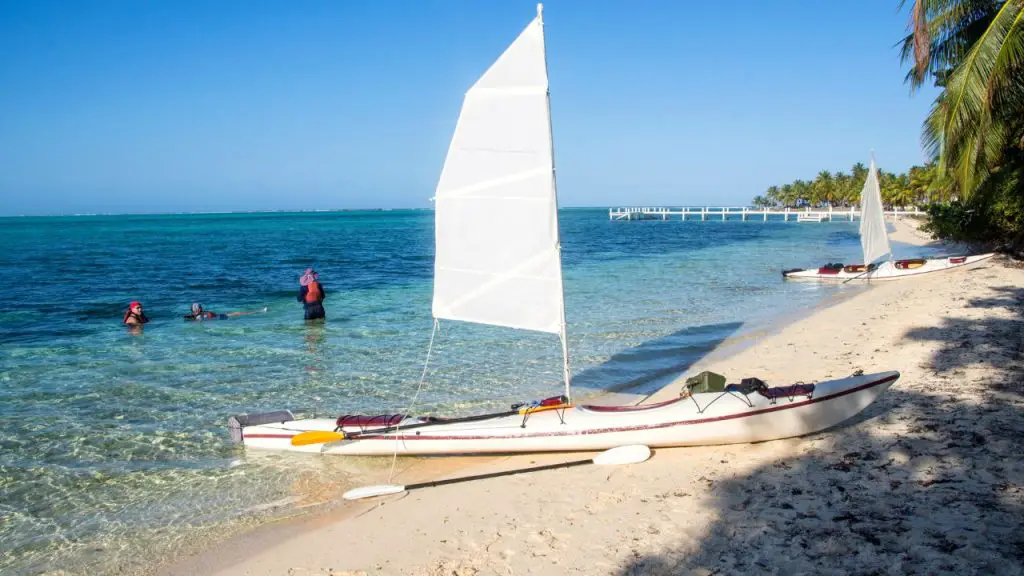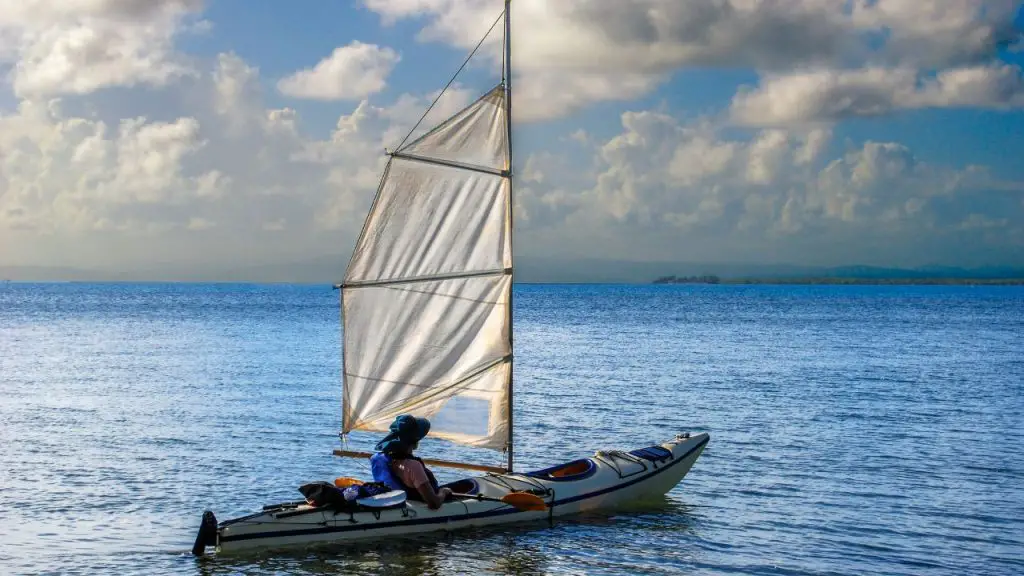If you paddle your kayak for hours at a stretch, the process is bound to get tiring at some point. Installing a kayak sail sounds like a great idea. But the question is: do kayak sails work?
It’s a burning question for many novice kayakers. If a kayak sail actually works, the whole process of kayaking is likely to get a lot easier and more fun. Relying on the power of the wind can help a kayaker spend more time on the water.
In this post, we are going to discuss everything you need to know about installing a sail on your kayak. Hopefully, here you will find answers to some of your nagging questions. Keep reading!
Table of Contents
Do Kayak Sails Really Work?

Yes, kayak sails work. A sail uses the power of the wind and propels your kayak forward. By installing a kayak sail, you can gain more speed and travel longer distances while avoiding physical exhaustion. Harnessing the power of light winds or a breeze can make long paddling trips more enjoyable.
While the average speed of a conventional sea kayak is only 3-4 knots, a kayak with a sail can gain an average speed of 7 knots. In some cases, the speed can hit 10 knots.
Pros and Cons When Adding a Kayak Sail
Installing a sail can help you gain more speed and conserve energy for long trips, but there are some notable disadvantages as well. Here are the pros and cons at a glance:
| Pros | Cons |
| – The most remarkable advantage of installing a kayak sail is that you gain speed without having to paddle vigorously – By utilizing the power of wind, you can conserve your physical stamina while traveling faster – You do not get tired too quickly. As a result, you can spend more time on the water and cover long distances – Instead of paddling non-stop, you can take a break from time to time – Kayaking is a lot more enjoyable when you can travel faster while expending less energy | – Adding a sail affects the stability of your kayak, particularly when the winds are strong – If you do not secure the sail appropriately, you run the risk of tipping over – To some extent, it limits your ability to roll |
When Do You Use a Kayak Sail?
Kayak sails are useful for long trips. If you are going to paddle just for a few hours, you probably do not need a sail. A kayak sail can also be used to find the direction of the wind.
A beginner learning the nuances of kayaking should not move too fast. To prevent capsizing and ensure better control, try to keep the speed below 10 knots.
If you are paddling in a narrow river with overhanging trees, adding a sail to your kayak may not be a good idea. Unless there is wind or strong currents, a kayak sail is practically useless. So, get a sail only if there is wind. Do not use a sail if the wind is too strong, because it will affect your kayak’s overall stability.
It is to be noted here that there is no such thing as an ideal wind speed, and the success of sailing depends on a host of factors. They include boat type, location, your skill level and your overall approach to the trip.

Types of Kayak Sails
Depending on the way kayak sails are grouped together, there are about six different types of them. Down below we are going to discuss kayak sails be design, materials and shape.
Kayak Sails by Design
In terms of design, there are three main types of kayak sails. Here they are:
- Downwind Sails
Also known as kite sails, downwind sails are reasonably sturdy and rigid, and are designed to withstand up to 15 knots of sea wind. These sails are small and lightweight, and therefore easily transportable. If the winds become very strong, you can easily remove a downwind sail to avoid capsizing.
While downwind kayak sails are great in terms of their ease of use, they provide very little room for maneuverability. Here are the pros and cons at a glance:
| Pros | Con |
| – Easy to set up – Withstands pretty strong winds | – Offers very little maneuverability |
- Free-Standing Sails
Free-standing sails are mostly L-shaped. In terms of their technical aspect, they work almost the same way as real sails on boats. You have to hoist a free-standing sail on a mast. It is remarkably maneuverable, and works in various wind conditions.
Pros and cons of free-standing sails:
| Pros | Cons |
| – Depending on the wind direction, the sail can be switched in different directions – The sail is adjusted higher up, which allows you to clearly see things in front of you – Free-standing sails are remarkably sturdy and durable | – Installation is a bit complicated. The process involves drilling holes to install rigging – Managing the sail requires some level of experience. You have to learn how to adapt to different winds |
- Full Sailing Rigs
A full sailing rig, which is circular in shape, is the best option for a novice kayaker. Plastic is the most commonly used material for this type of sail. It has a visor in the middle, which allows you to see objects in front of you. The sail comes with some hooks intended to be positioned on the front end or bungee area of your kayak.
Pros and cons of full sailing rigs:
| Pros | Cons |
| – Very easy to install, and therefore great for beginners – The best type of kayak sail to use on the sea or on a lake | – Unless the wind is strong, you will not gain much speed with a full sailing rig |
Kayak Sail by Materials
The most commonly used materials for manufacturing kayak sails are plastic, laminated cloth, carbon fiber and aluminum, and synthetic fabrics.
- Plastic
Plastic is the go-to material for kayak sails because it is flexible, durable, hard-wearing and lightweight. With that said, unless they are taken care of, plastic sails tend to degrade and split. These sails are less durable than aluminum and carbon fiber sails.
Pros and cons:
| Pros | Cons |
| – Flexible and lightweight – Easy to carry and install | – You need to clean a plastic sail after each use, because salt from sea water can cause the sail to split – Less durable than aluminum or carbon fiber sails |
- Laminated Cloth
Sails made of laminated cloth are known for their great tensile strength. They can withstand strong winds. However, they are thick and heavy, and therefore a bit hard to store, carry and put up. They are highly efficient as long as they are dry.
Pros and cons:
| Pros | Cons |
| – Best material for L-shaped sails – Great tensile strengthHighly efficient when dry | – Thick and heavy – Not easy to put up |

- Carbon Fiber and Aluminum
Thanks to their durability, carbon fiber and lightweight aluminum are often used for manufacturing various types of kayak sails. Whenever the design of a sail involves a mast, fiber and aluminum are the go-to materials.
The supporting rod used to stiffen a circular sail is usually made of plastic, even if the primary material of the sail is aluminum or carbon fiber.
Pros and cons:
| Pros | Cons |
| – Lightweight and durable – Great for L-shaped sails | – Not as cheap as plastic sails |
- Synthetic Fibers
Synthetic fibers such as polyester, nylon and rayon are also among the most widely used materials for kayak sails. These sails are lightweight and durable, and provide protection against ultraviolet radiation.
Pros and cons:
| Pros | Cons |
| – Long-lastingEasily repairable – Provide protection against UV rays | A bit heavy |
Kayak Sails by Shape
In terms of shape, there are three types of kayak sails: L-shaped, circular, and V-shaped sails. Let’s dive a little bit deeper.
L-shaped sails are intended to be used by experienced kayak sailors. Using these large sails requires some expertise because they are not just for downwind use. You can use an L-shaped kayak sail regardless of the direction of the wind.
Pros and cons:
| Pros | Cons |
| – L-shaped sails offer great maneuverability. You can adjust the direction of your kayak based on the wind direction – They are adjusted higher up, and therefore do not block your vision | – Installation is rather complicated |
- Circular Sails
Circle-shaped sails are great for downwind situations. While they are very well-known kayak sails, they do not offer sufficient mobility. You have to set up a circular sail the same way you set up a pop-up tent.
Pros and cons:
| Pros | Cons |
| – Easy to store and carry – Easy to set upSuitable for beginners | – Only for downwind use |
Kayak Downwind Wind Sail
- V-shaped Sails
V-shaped kayak sails function the same way as circular sails, but are a bit more sophisticated in design. When filled with air, a V-shaped sail looks bell-shaped. These sails are smaller, and pretty easy to carry and install.
Pros and cons:
| Pros | Cons |
| – V-shaped sails are usually made of more durable materials – They come with a visor, just like circular sails | – A V-shaped sail has a smaller surface area, so it catches less wind |
Sea Eagle QuikSail Kayak Sail
How To Choose The Right Kayak Sail
When it comes to choosing a kayak sail, there is no such thing as the best sail. Users have a plethora of options to choose from.
When making a choice, your personal preference and experience level are the most important factors to take into consideration. If you are a beginner, consider opting for a smaller sailboat, because you will find it relatively easy to control.
If you think you need a downwind spinnaker, Heayzoki Boat Wind Sail is one of the best products to try. This sail is sturdy and durable, and provides protection against ultraviolet radiation. You will find this small and lightweight sail pretty easy to install.
If you have a preference for a compact design, go for RapidUp Kayak Sail. Made of durable sail cloth, this sail is easy to carry and set up. It comes with two side windows and a large central window that offers clear visibility. The sail is compatible with almost all types of kayak decks.
And for a kayaker looking for a budget sail, Dyna-Living Kayak Sail may be the right choice. This nylon-made sail is compact in design and very easy to set up. It comes with a strong, almost unbreakable perimeter batten. The transparent window enables you to clearly see things behind the sail.
FAQs
Can you sail a kayak into the wind?
Yes you can, and installing an upwind sail rig can make the process a lot easier for you. Regardless of the type of kayaking spot you choose, you can install a kayak sail and sail your kayak into the wind.
How far can a beginner kayak in a day?
A beginner kayaker can travel about a couple of miles per hour. That means, if a beginner kayaker paddles for five hours a day, he or she will end up traveling about 10 miles. In contrast, an experienced kayaker can cover 3 to 4 miles per hour. If there is a wind, installing a sail is a great way to speed up your kayak.
How long does it take to kayak 13 miles?
An experienced kayaker can cover 3 to 4 miles per hour. So, he or she will need 3-4 hours to kayak 13 miles. A beginner kayaker, in contrast, needs 6-7 hours to cover the same distance. A kayak with a sail can cover this distance in just a couple of hours.
The Bottom Line
Installing a sail can help you kayak faster while expending less energy. Not all kayak sails are the same, so you have to choose one based on factors such as your kayak, the kayaking spot you choose, and your level of experience.
If you have never used a kayak sail, opt for a compact and lightweight model so that you can manage it without much effort. As you experiment with multiple sails and gain experience, you will gradually figure out what works best for you.


